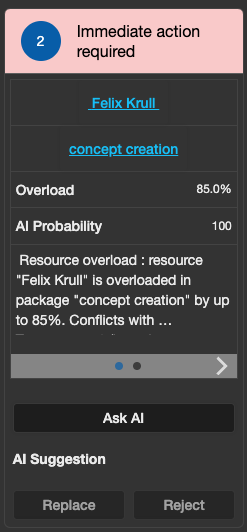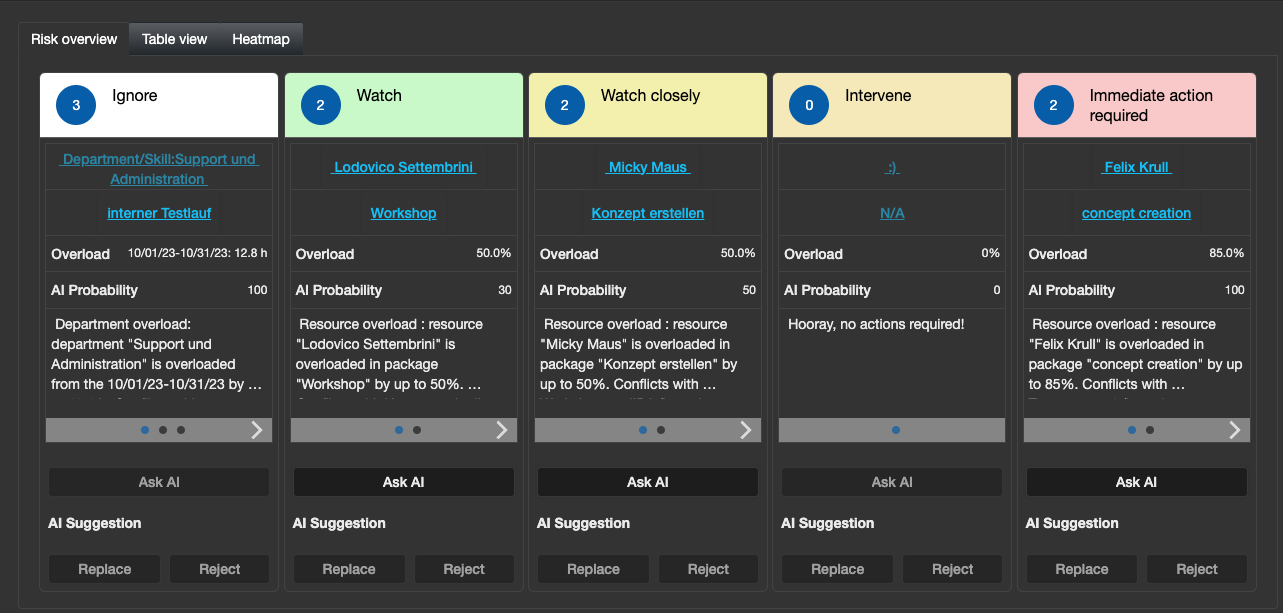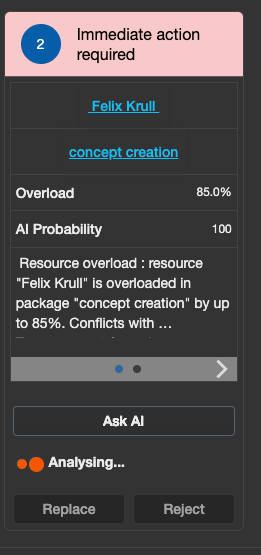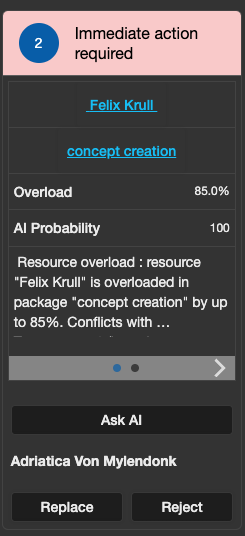Enhance Project Planning with Can Do's Simulation Mode
Decisions have to be made constantly in project and resource planning. What happens if an important project starts...
3 min read
![]() Thomas Schlereth
:
05.07.2023
Thomas Schlereth
:
05.07.2023
We have now almost completed the next generation in Can Do's resource management tool.
.png?width=750&height=500&name=Can%20Do%20User%20Blog%20Academy(5).png)
The previous AI, which indicates a recommended action when people are overloaded, gets another model in addition. This model suggests concrete alternative resources. The new model is far more adaptive than the current AI.
The previous AI that determines recommended actions is a rule-based system with a very weak learning domain.
The new AI, on the other hand, is fully capable of learning and belongs more to the machine learning (ML) category. More precisely, this AI works according to the IRL (Inverse Reinforcement Learning) method and learns from the user.

One solution approach for project managers in the case of an overloaded resource is to schedule another person to do the work. However, this person must meet several criteria to be eligible. These are, for example, sufficient availability and - most importantly - the necessary skills to do the work instead of another person.
Can Do is also a skill management software and all resources can have skills. It is also possible for the project manager to specify which of his many skills the employee performs when assigning the resource. However, this is simply too much work for project managers.
Can Do has to find out which person can replace another person in case of overload.

The illustration shows that the AI has found 2 overloads in the whole project, where the "old" AI advises to "intervene immediately". The illustration is completely redesigned and looks completely like this:

Within the first layers of the AI, we have already firmly defined the first learning models. This is to prevent the AI from trying all of a company's resources when searching for alternatives. In installations with 4,500 users, this would take far too long and the results would be questionable. Therefore, the AI assumes, for example, that people in the same department may also have similar skills. There are other assumptions that help the AI search more specifically
The AI has identified an alternative person and simulated their availability. This means that if the alternative person comes into question and is used, the risk situation is better than it currently is. The suggestion is therefore an alternative person of whom the AI assumes that this person can also perform the work and is sufficiently available.


The lower layers in Can Do identify and assess the overload risk. They make a recommendation such as "intervene". The project planner can now have an alternative suggested for this particular risk. He can accept this (replace) and have the current risk resource in this work package replaced by the new resource. Work that has already been done is taken into account.
If he rejects the proposal of the AI, another resource is suggested to him. This can be just as suitable, but not better. A maximum of 5 resources are suggested. If all suggestions are rejected by the project manager, the AI is at the end of its possibilities and can no longer help here.
The button below "Ask AI" triggers the new AI, the AI now starts to find alternative people and also simulates if the capacity is sufficient. If a resource is found, it will be displayed. Here is the whole process in a short video:
The assessment of whether a person can take over the work of another person is best made by humans. So when the project manager accepts or rejects a proposal, the AI learns from him. Over time, the AI gets to know the people in the company better and better, so to speak, and makes better and better suggestions.
This list is extremely long, here is just an off-the-cuff list:
We don't know for sure yet. The first internal training at Can Do was promising. In July 2023, the beta version will go to three selected cloud customers. There, the AI will then be trained by the customers on a company-specific basis.
Ultimately, we will survey users to see if the suggestions make sense and save you a lot of time.
As soon as the first round of training is completed in the summer, I will report the results here and then also communicate a concrete release date.
As a member of the management board, Thomas is responsible for the operative management of the development including conception, design and further development of the software. He also advises customers on best practices and supports the roll-out.
Decisions have to be made constantly in project and resource planning. What happens if an important project starts...
The ME+ app was developed to help employees and teams manage their working hours and tasks more efficiently. It is...
In a fast-paced and ever-changing work environment, team and department leaders face the challenge of not only leading...